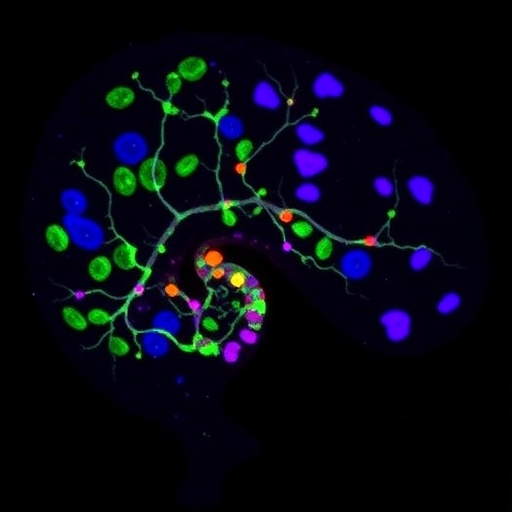In the evolving landscape of cancer research, new and groundbreaking findings continue to emerge, which challenge the boundaries of our understanding of tumor biology. A recent study led by a team of researchers, including Jin, Dong, and Xie, has shed light on the role of the LncRNA938/TAF9/TTK axis in the process of epithelial-mesenchymal transition (EMT) specifically in hepatoblastoma, a rare but aggressive cancer that primarily affects children. This novel axis has been identified not only as a critical player in the development and progression of hepatoblastoma but also as a potential therapeutic target for treatment strategies.
Hepatoblastoma, characterized by its origins in the liver, has been a subject of concern for pediatric oncologists due to its aggressive nature and the challenges it poses to existing treatment modalities. The etiology of this cancer remains poorly understood, which further complicates therapeutic approaches. The study highlights that the dysregulation of specific long non-coding RNAs (lncRNAs) can lead to significant changes in cellular behavior, thereby contributing to the invasive and metastatic nature of tumors.
In the investigation, the researchers utilized a combination of cellular and molecular biology techniques to elucidate the interactions between lncRNA938, TAF9, and TTK. These components collectively influence the EMT process—a critical mechanism by which epithelial cells transition to a mesenchymal state, thereby gaining increased motility and invasiveness. The findings reveal that the lncRNA938 plays a pivotal role in regulating the expression of TAF9 and TTK, two proteins that are integral to the EMT process.
As the researchers delved deeper, they discovered that the expression levels of lncRNA938 were significantly elevated in hepatoblastoma tissues compared to normal liver tissues. Functional assays demonstrated that the knockdown of lncRNA938 led to a substantial reduction in the invasive and migratory capabilities of hepatoblastoma cells, indicating its contributory role in promoting tumor aggressiveness. These findings underscore the importance of lncRNA938 as a biomarker that could aid in the identification of high-risk patients.
The study did not merely stop at establishing correlations; it ventured into the functional impact of targeting the lncRNA938/TAF9/TTK axis in therapeutic contexts. Utilizing both in vitro and in vivo models, the researchers explored the consequences of disrupting this axis on tumor growth and metastasis. The in vivo experiments, particularly, demonstrated promising results, revealing that silencing lncRNA938 significantly inhibited tumor growth in xenograft models. This discovery points towards the potential for developing targeted therapies that could mitigate the detrimental effects of hepatoblastoma.
Moreover, TAF9 and TTK, being downstream effectors of lncRNA938, emerged as critical players in the signaling pathways that govern cell proliferation and survival. The interplay among these molecules presents an intricate web of regulatory mechanisms where lncRNA938 emerges as a master regulator, orchestrating the expression of genes pivotal for the EMT process. By directly influencing the stability and activity of TAF9 and TTK, lncRNA938 offers a novel insight into the complexities of cancer biology.
Given the aggressive nature of hepatoblastoma and the limited treatment options available, this research holds substantial significance. The identification of the LncRNA938/TAF9/TTK axis as a potential therapeutic target could inspire new treatment paradigms. Efforts are now warranted to translate these findings into clinical applications, which could revolutionize the way hepatoblastoma is treated and managed. Future studies could explore the therapeutic efficacy of small molecules or RNA-based therapies that specifically target lncRNA938 to enhance patient outcomes.
As the research community continues to unravel the complexities of lncRNAs and their roles in cancer, the insights from this study are timely. The growing recognition of lncRNAs as key regulatory molecules in various cancer types begs further exploration into their roles as mediators of tumorigenesis and metastasis. With the advent of advanced genome-editing techniques and RNA-targeting therapeutics, the potential to modify the expression or function of critical lncRNAs presents an exciting frontier in cancer therapy.
The evidence presented in the study certainly paves the way for innovative therapeutic approaches that harness the power of RNA-based interventions. As scientists endeavor to bridge the gap between laboratory findings and clinical applications, the urgency to translate such research into viable treatment strategies for hepatoblastoma becomes paramount.
Furthermore, as researchers collect more data and gain further insights into the regulatory networks orchestrated by lncRNAs, it is conceivable that they will identify additional pathways and targets that could broaden the scope of treatment options for hepatoblastoma and potentially other malignancies. This research not only highlights the role of the LncRNA938/TAF9/TTK axis but also underscores the importance of embracing a multi-faceted approach in cancer research that encompasses both basic science and clinical applications.
In summary, the study on the LncRNA938/TAF9/TTK axis illuminates a promising avenue for therapeutic intervention in hepatoblastoma, propelling forward our understanding of cancer biology. As we stand at the intersection of innovation and healthcare, the findings underscore the imperative to leverage emerging scientific insights into actionable treatment options that could ultimately enhance survival rates for children afflicted with this formidable disease.
Subject of Research: The role of LncRNA938/TAF9/TTK axis in epithelial-mesenchymal transition and its potential as a therapeutic target in hepatoblastoma.
Article Title: LncRNA938/ TAF9/TTK axis promotes EMT and serves as a therapeutic target in hepatoblastoma.
Article References:
Jin, C., Dong, B., Xie, Y. et al. LncRNA938/ TAF9/TTK axis promotes EMT and serves as a therapeutic target in hepatoblastoma. J Transl Med 23, 946 (2025). https://doi.org/10.1186/s12967-025-06809-4
Image Credits: AI Generated
DOI: 10.1186/s12967-025-06809-4
Keywords: LncRNA938, hepatoblastoma, TAF9, TTK, epithelial-mesenchymal transition, therapeutic target, cancer research.
Tags: aggressive childhood cancersCancer Treatment Strategiesepithelial-mesenchymal transitionhepatoblastoma treatmentliver cancer in childrenLncRNA938long non-coding RNAs in cancerpediatric oncology researchTAF9therapeutic targets in cancerTTK axistumor biology advancements





